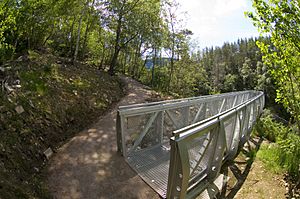Corrieshalloch Gorge facts for kids
Quick facts for kids Corrieshalloch Gorge National Nature Reserve |
|
|---|---|
|
IUCN Category III (Natural Monument)
|
|

Corrieshalloch Gorge and Falls of Measach
|
|
| Location | Ullapool, Scotland |
| Area | 7 ha (17 acres) |
| Designation | NatureScot |
| Established | 1967 |
| Owner | National Trust for Scotland |
| Corrieshalloch Gorge National Nature Reserve | |
Corrieshalloch Gorge is an amazing deep valley in the Scottish Highlands. It's about 20 kilometers south of Ullapool. In Scottish Gaelic, its name is Coire Shalach, which means 'unattractive corrie'. A corrie is a bowl-shaped hollow in a mountain.
This gorge is about 1.5 kilometers long. It's also 60 meters deep and 10 meters wide at the top. The Abhainn Droma river flows through Corrieshalloch. Below the gorge, the land opens up into a wide, flat valley. This valley was carved out by glaciers.
Inside the gorge, you'll find the 46-meter-high Falls of Measach. Its Gaelic name, Easan na Miasaich, means 'waterfalls of the place of platters'. This refers to the cool pot-holes the water has worn into the rock. You can see these falls from a special viewing platform. There's also an old Victorian suspension footbridge. The National Trust for Scotland has owned the gorge since 1945. They manage it with NatureScot.
How the Gorge Was Formed
Corrieshalloch Gorge is one of Scotland's most stunning gorges. It shows us how powerful melting glaciers can be. They can carve out very deep valleys. The gorge was formed at the end of the Quaternary ice age. This was about 10,000 to 13,000 years ago.
Huge sheets of ice covered northern Scotland back then. When this ice melted, the water flowed quickly. It found cracks and weak spots in the old Moine rock. Over time, this powerful water carved out the deep gorge we see today.
Visiting the Gorge
Corrieshalloch Gorge is a popular place to visit. There's a 25-meter-long footbridge. It stretches across the gorge right below the waterfalls. This bridge was built by Sir John Fowler, 1st Baronet. He also helped design the famous Forth Bridge.
You can reach the footbridge by walking a 300-meter path. This path starts from the car park on the south side of the gorge. There's a small charge of £2 to use the path. You pay this using an honesty box at the start. There is also a viewing platform. It sticks out into the gorge, giving you amazing views.
The bridge has been closed a few times for repairs. For example, it was closed in 2010 and again in 2011-2012. This was to fix wear and tear. It fully reopened in May 2012 after major repairs. Today, it's recommended that no more than six people are on the bridge at one time. In 2019, plans were announced for new parking and a visitor center.
Nature and Conservation
The gorge is a special home for many plants. These plants have mostly disappeared from nearby areas. This is because animals graze there. The dark, damp walls of the gorge are perfect for ferns and feather mosses. You can also find sanicle here.
Wood millet is another plant found here. It's quite rare in northwest Scotland. Higher up, where it's sunnier, you'll see trees. These include wych elm, birch, sycamore, Norway maple, and beech.
The wooded parts of the gorge are home to a rare insect. It's a type of cranefly called Lipsothrix ecucullata. The young craneflies live in wet, decaying wood. The adult craneflies prefer damp woodlands.
Corrieshalloch Gorge is a National Nature Reserve (NNR). It's also a Site of Special Scientific Interest (SSSI). This means it's a very important place for nature. It's protected by the International Union for Conservation of Nature. Corrieshalloch is the smallest of Scotland's 43 national nature reserves.
Sometimes, unwanted plants try to grow in the gorge. These are called alien plant species. Examples include rhododendron and Japanese knotweed. Experts use special ways to remove them. This helps protect the gorge's unique natural environment.



